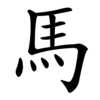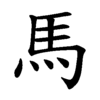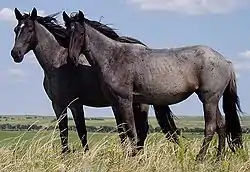馬
| ||||||||
| ||||||||
Translingual
| Stroke order | |||
|---|---|---|---|
 | |||
| Stroke order (Hong Kong) | |||
|---|---|---|---|
 | |||
Han character
馬 (Kangxi radical 187, 馬+0, 10 strokes, cangjie input 尸手尸火 (SQSF), four-corner 71327, composition ⿹⿺㇉⿻三丨灬)
- Kangxi radical #187, ⾺.
Derived characters
Related characters
References
- KangXi: page 1433, character 1
- Dai Kanwa Jiten: character 44572
- Dae Jaweon: page 1956, character 34
- Hanyu Da Zidian (first edition): volume 7, page 4539, character 1
- Unihan data for U+99AC
Chinese
Glyph origin
| Historical forms of the character 馬 | |||||||||||
|---|---|---|---|---|---|---|---|---|---|---|---|
| Shang | Western Zhou | Spring and Autumn | Warring States | Shuowen Jiezi (compiled in Han) | Liushutong (compiled in Ming) | Libian (compiled in Qing) | |||||
| Bronze inscriptions | Oracle bone script | Bronze inscriptions | Bronze inscriptions | Bronze inscriptions | Chu slip and silk script | Qin slip script | Shizhoupian script | Ancient script | Small seal script | Transcribed ancient scripts | Clerical script |
 |
 |
 |
 |
 |
 |
 |
 |
 |
 |
 |
 |
| Semi-cursive script | Cursive script |
|---|---|
 |
 |
Pictogram (象形) – a horse with its head facing the left, showing a flowing mane in the wind. In the bronze inscriptions, the head was often simplified into an eye (目). The legs eventually evolved into four dots (灬, unrelated to 火).
Contrast with 鹿 (“deer”), which saw a very different development, and 𢊁 (as in 薦), which is a hybrid: it has the legs of 馬 (灬) but the head of 鹿.
Etymology
| trad. | 馬 | |
|---|---|---|
| simp. | 马 | |
| alternative forms | ||
“Horse” – from Proto-Sino-Tibetan *k-m-raŋ ~ s-raŋ. The sense of “big” is derived from “horse”; compare the English uses of horse.
For the insect prefix sense, see 螞. It has converged with the sense of “big”.
The surname is popularly known to be prevalent among Hui Muslims, where it is likely derived from Arabic مُحَمَّد (muḥammad, “Muhammad”), although the surname 馬 itself predates Islam.
Pronunciation
Definitions
馬
- horse (Classifier: 匹 m c; 隻/只 m c)
- horse-shaped
- (chess) knight
- (xiangqi) knight; horse (on the black side)
- Original form of 碼/码 (mǎ, “chip for counting”).
- big (prefix for nouns)
- (Southwestern Mandarin, including Sichuanese) to bully
- (Sichuanese) to keep a straight face
- Prefix for names of insects, also written as 螞.
- Short for 馬祖/马祖 (Mǎzǔ, “Matsu”).
- Short for 馬來西亞/马来西亚 (Mǎláixīyà, “Malaysia”).
- (Mainland China) Short for 馬克思/马克思 (Mǎkèsī, “Marx”).
- a surname
Synonyms
Coordinate terms
Compounds
- 一馬當先/一马当先 (yīmǎdāngxiān)
- 上馬/上马 (shàngmǎ)
- 下馬/下马 (xiàmǎ)
- 下馬碑/下马碑 (xiàmǎbēi)
- 並馬/并马 (bìngmǎ)
- 乘馬/乘马
- 乞力馬扎羅山/乞力马扎罗山
- 五馬/五马 (Wǔmǎ)
- 人善得人欺,馬善得人騎/人善得人欺,马善得人骑 (rén shàn dé rén qī, mǎ shàn dé rén qí)
- 人馬/人马 (rénmǎ)
- 代馬/代马
- 伽馬/伽马 (gāmǎ)
- 倒馬/倒马
- 備馬/备马 (bèimǎ)
- 兒馬/儿马 (érmǎ)
- 兵馬/兵马 (bīngmǎ)
- 出馬/出马 (chūmǎ)
- 前馬/前马
- 剗馬/刬马
- 劣馬/劣马
- 勒馬/勒马 (lèmǎ)
- 千軍萬馬/千军万马 (qiānjūnwànmǎ)
- 千里馬/千里马 (qiānlǐmǎ)
- 口馬/口马
- 叩馬/叩马
- 司馬/司马 (sīmǎ)
- 哨馬/哨马
- 單馬/单马 (dānmǎ)
- 回馬/回马 (huímǎ)
- 圈馬/圈马 (juānmǎ)
- 報馬/报马 (bàomǎ)
- 墮馬/堕马 (duòmǎ)
- 墜馬/坠马
- 夏馬勒巴格/夏马勒巴格 (Xiàmǎlèbāgé)
- 多馬/多马 (Duōmǎ)
- 大馬/大马 (Dàmǎ)
- 夫馬/夫马
- 天馬/天马 (tiānmǎ)
- 天馬行空/天马行空 (tiānmǎxíngkōng)
- 奔馬/奔马 (bēnmǎ)
- 官馬/官马
- 害群之馬/害群之马 (hàiqúnzhīmǎ)
- 害馬/害马
- 寶馬/宝马 (bǎomǎ)
- 弓馬/弓马 (gōngmǎ)
- 征馬/征马
- 心猿意馬/心猿意马 (xīnyuányìmǎ)
- 怒馬/怒马
- 意馬/意马
- 懸崖勒馬/悬崖勒马 (xuányálèmǎ)
- 戎馬/戎马 (róngmǎ)
- 戰馬/战马 (zhànmǎ)
- 扇馬/扇马
- 打馬/打马
- 扣馬/扣马
- 拉馬/拉马
- 拒馬/拒马 (jùmǎ)
- 拍馬/拍马 (pāimǎ)
- 拍馬屁/拍马屁 (pāi mǎpì)
- 指鹿為馬/指鹿为马 (zhǐlùwéimǎ)
- 探馬/探马 (tànmǎ)
- 控馬/控马
- 撥馬/拨马 (bōmǎ)
- 斑馬/斑马 (bānmǎ)
- 服馬/服马
- 木馬/木马 (mùmǎ)
- 東馬/东马 (Dōng-Mǎ)
- 東馬坊/东马坊 (Dōngmǎfáng)
- 樸馬/朴马
- 櫪馬/枥马
- 歇馬/歇马 (xiēmǎ)
- 歇馬廟/歇马庙 (Xiēmǎmiào)
- 水馬/水马 (shuǐmǎ)
- 汗馬/汗马
- 河馬/河马 (hémǎ)
- 法馬/法马
- 泥馬/泥马
- 洗馬/洗马
- 海馬/海马 (hǎimǎ)
- 灶馬/灶马 (zàomǎ)
- 燙馬/烫马
- 牛馬/牛马 (niúmǎ)
- 牧馬/牧马 (mùmǎ)
- 牽馬/牵马 (qiānmǎ)
- 犬馬/犬马 (quǎnmǎ)
- 狗馬/狗马
- 玉馬/玉马
- 班馬/班马
- 甲馬/甲马
- 疋馬/疋马
- 瘦馬/瘦马 (shòumǎ)
- 發馬/发马
- 白馬/白马 (báimǎ)
- 白馬寺/白马寺 (Báimǎsì)
- 盜馬/盗马 (dàomǎ)
- 盤馬/盘马
- 相馬/相马
- (Min Nan) 碌硞馬/碌硞马 (lo̍k-kho̍k-bé)
- 神馬/神马 (shénmǎ)
- 祿馬/禄马 (lùmǎ)
- 禿馬/秃马
- 秣馬/秣马
- 秧馬/秧马
- 竹馬/竹马 (zhúmǎ)
- 策馬/策马 (cèmǎ)
- 簷馬/檐马
- 籌馬/筹马 (chóumǎ)
- 紅馬廟/红马庙 (Hóngmǎmiào)
- 紙馬/纸马 (zhǐmǎ)
- 練馬師/练马师 (liànmǎshī)
- 縱馬/纵马 (zòngmǎ)
- 羅馬/罗马 (Luómǎ)
- 群馬/群马 (Qúnmǎ)
- 老馬識途/老马识途 (lǎomǎshítú)
- 背馬/背马
- 胡馬/胡马
- 良馬/良马 (liángmǎ)
- 荷馬/荷马 (Hémǎ)
- 菜馬/菜马
- 落馬/落马 (luòmǎ)
- 薊馬/蓟马
- 薩其馬/萨其马 (sàqímǎ)
- 蛛絲馬跡/蛛丝马迹 (zhūsīmǎjì)
- 衣馬/衣马
- 裘馬/裘马
- 角馬/角马
- 課馬/课马
- 賭馬/赌马
- 賽馬/赛马 (sàimǎ)
- 赤馬港/赤马港 (Chìmǎgǎng)
- 走馬/走马 (zǒumǎ)
- 走馬嶺/走马岭 (Zǒumǎlǐng)
- 走馬看花/走马看花
- 起馬/起马
- 趟馬/趟马
- 跑馬/跑马 (pǎomǎ)
- 跳馬/跳马 (tiàomǎ)
- 躍馬/跃马 (yuèmǎ)
- 車水馬龍/车水马龙 (chēshuǐmǎlóng)
- 車馬/车马 (chēmǎ)
- 車馬費/车马费 (chēmǎfèi)
- 軍馬/军马 (jūnmǎ)
- 輿馬/舆马
- 造馬/造马 (zàomǎ)
- 這馬/这马 (chit-má)
- 遛馬/遛马
- 郡馬/郡马
- 重馬/重马
- 野馬/野马 (yěmǎ)
- 金馬/金马 (jīnmǎ)
- 鋪馬/铺马
- 鎧馬/铠马
- 鐵馬/铁马 (tiěmǎ)
- 長馬/长马
- 阿胡拉·馬茲達/阿胡拉·马兹达 (Āhúlā Mǎzīdá)
- 阿馬/阿马 (Āmǎ)
- 陣馬/阵马
- 陳馬/陈马 (Chénmǎ)
- 鞍馬/鞍马 (ānmǎ)
- 鞴馬/鞴马
- 響馬/响马
- 頭馬/头马
- 風馬牛不相及/风马牛不相及 (fēng mǎ niú bù xiāngjí)
- 飛馬/飞马 (fēimǎ)
- 飲馬/饮马 (yìnmǎ)
- 馬上/马上 (mǎshàng)
- 馬不停蹄/马不停蹄 (mǎbùtíngtí)
- 馬乳/马乳
- 馬乾/马干
- 馬來/马来 (Mǎlái)
- 馬來半島/马来半岛 (Mǎlái Bàndǎo)
- 馬來西亞/马来西亚 (Mǎláixīyà)
- 馬克/马克 (mǎkè)
- 馬克思/马克思 (Mǎkèsī)
- 馬克杯/马克杯 (mǎkèbēi)
- 馬內/马内
- 馬公/马公 (Mǎgōng)
- 馬兵/马兵
- 馬其頓/马其顿 (Mǎqídùn)
- 馬冠/马冠
- 馬刀/马刀 (mǎdāo)
- 馬利/马利 (Mǎlì)
- 馬到成功/马到成功 (mǎdào-chénggōng)
- 馬力/马力 (mǎlì)
- 馬勃/马勃 (mǎbó)
- 馬勺/马勺 (mǎsháo)
- 馬匹/马匹 (mǎpǐ)
- 馬口/马口 (Mǎkǒu)
- 馬可/马可 (Mǎkě)
- 馬吊/马吊
- 馬哨/马哨
- 馬嘶/马嘶 (mǎsī)
- 馬圈/马圈 (mǎjuàn)
- 馬圖/马图
- 馬坪/马坪 (Mǎpíng)
- 馬埒/马埒
- 馬場/马场 (mǎchǎng)
- 馬塹/马堑 (Mǎqiàn)
- 馬太/马太 (Mǎtài)
- 馬夫/马夫 (mǎfū)
- 馬奈/马奈
- 馬奴/马奴
- 馬子/马子 (mǎzi)
- 馬安/马安 (Mǎ'ān)
- 馬家坳/马家坳 (Mǎjiā'ào)
- 馬家寨/马家寨 (Mǎjiāzhài)
- 馬家嶺/马家岭 (Mǎjiālǐng)
- 馬家店/马家店 (Mǎjiādiàn)
- 馬封/马封
- 馬將/马将
- 馬尾/马尾 (mǎwěi)
- 馬屁/马屁 (mǎpì)
- 馬山/马山 (Mǎshān)
- 馬崗/马岗 (Mǎgǎng)
- 馬嵬/马嵬 (Mǎwéi)
- 馬帳/马帐
- 馬帴/马𰏕 (mǎjiān)
- 馬幣/马币 (Mǎbì)
- 馬幫/马帮
- 馬店/马店 (Mǎdiàn)
- 馬廄/马厩 (mǎjiù)
- 馬廠/马厂
- 馬弁/马弁
- 馬後砲/马后炮 (mǎhòupào)
- 馬德里/马德里 (Mǎdélǐ)
- 馬快/马快
- 馬恩列斯/马恩列斯 (Mǎ-Ēn-Liè-Sī)
- 馬戲/马戏 (mǎxì)
- 馬房/马房 (mǎfáng)
- 馬扁/马扁
- 馬拉/马拉
- 馬拉松/马拉松 (mǎlāsōng)
- 馬拉維/马拉维 (Mǎlāwéi)
- 馬掌/马掌 (mǎzhǎng)
- 馬援/马援
- 馬斯特里赫特/马斯特里赫特 (Mǎsītèlǐhètè)
- 馬曹廟/马曹庙 (Mǎcáomiào)
- 馬札/马札
- 馬杓/马杓
- 馬杆/马杆
- 馬架/马架
- 馬桶/马桶 (mǎtǒng)
- 馬桶刷/马桶刷 (mǎtǒngshuā)
- 馬棚/马棚 (mǎpéng)
- 馬棒/马棒
- 馬椅/马椅 (bé-í)
- 馬槍/马枪 (mǎqiāng)
- 馬槽/马槽 (mǎcáo)
- 馬樁/马桩 (mǎzhuāng)
- 馬橋/马桥 (Mǎqiáo)
- 馬欄/马栏 (Mǎlán)
- 馬步/马步 (mǎbù)
- 馬江/马江
- 馬河/马河 (Mǎhé)
- 馬流/马流
- 馬灣/马湾 (Mǎwān)
- 馬熊/马熊 (mǎxióng)
- 馬燈/马灯 (mǎdēng)
- 馬爾代夫/马尔代夫 (Mǎ'ěrdàifū)
- 馬爾比基/马尔比基
- 馬爾薩斯/马尔萨斯
- 馬特峰/马特峰
- 馬王/马王
- 馬班/马班
- 馬球/马球 (mǎqiú)
- 馬甲/马甲 (mǎjiǎ)
- 馬留/马留 (mǎliú)
- 馬眼/马眼 (mǎyǎn)
- 馬祖/马祖 (Mǎzǔ, “Matsu”)
- 馬票/马票 (mǎpiào)
- 馬童/马童
- 馬策/马策
- 馬糊/马糊
- 馬糞/马粪 (mǎfèn)
- 馬紹爾/马绍尔 (Mǎshào'ěr)
- 馬群/马群
- 馬腦/马脑
- 馬腳/马脚 (mǎjiǎo)
- 馬臺/马台
- 馬船/马船 (mǎchuán)
- 馬良/马良 (Mǎliáng)
- 馬蒂斯/马蒂斯
- 馬虎/马虎
- 馬號/马号 (Mǎhào)
- 馬蜂/马蜂 (mǎfēng)
- 馬蜂窩/马蜂窝 (mǎfēngwō)
- 馬蝨/马虱
- 馬融/马融
- 馬蟬/马蝉
- 馬蟥/马蟥
- 馬蟻/马蚁
- 馬蠅/马蝇
- 馬蠲/马蠲
- 馬術/马术 (mǎshù)
- 馬表/马表 (mǎbiǎo)
- 馬補/马补
- 馬褂/马褂 (mǎguà)
- 馬褲/马裤
- 馬調/马调
- 馬謖/马谡
- 馬賊/马贼
- 馬賽克/马赛克 (mǎsàikè)
- 馬赫/马赫 (Mǎhè)
- 馬趴/马趴 (mǎpā)
- 馬路/马路 (mǎlù)
- 馬蹄/马蹄 (mǎtí)
- 馬車/马车 (mǎchē)
- 馬軍/马军 (mǎjūn)
- 馬通/马通 (mǎtōng)
- 馬達/马达 (mǎdá)
- 馬道/马道
- 馬達加斯加/马达加斯加 (Mǎdájiāsījiā)
- 馬遞/马递
- 馬邑/马邑 (Mǎyì)
- 馬郎/马郎 (mǎláng)
- 馬里/马里 (Mǎlǐ)
- 馬里布/马里布 (Mǎlǐbù)
- 馬里蘭/马里兰 (Mǎlǐlán)
- 馬銜/马衔 (mǎxián)
- 馬鋪/马铺
- 馬鐙/马镫 (mǎdèng)
- 馬門/马门
- 馬關/马关 (Mǎguān)
- 馬陸/马陆 (mǎlù)
- 馬隊/马队
- 馬面/马面 (mǎmiàn)
- 馬靴/马靴 (mǎxuē)
- 馬鞍/马鞍 (mǎ'ān)
- 馬鞭/马鞭 (mǎbiān)
- 馬韀/马韀 (mǎjiān)
- 馬韉/马鞯 (mǎjiān)
- 馬頭/马头 (mǎtóu)
- 馬頰/马颊
- 馬食/马食
- 馬首是瞻/马首是瞻 (mǎshǒushìzhān)
- 馬馬虎虎/马马虎虎
- 馬駒/马驹 (mǎjū)
- 馬騮/马骝 (mǎliú)
- 馬騾/马骡 (mǎluó)
- 馬鬃/马鬃 (mǎzōng)
- 馬鬣/马鬣 (mǎliè)
- 馬鱉/马鳖 (mǎbiē)
- 馬鳴/马鸣
- 馬鼻/马鼻 (Mǎbí)
- 馬齒/马齿
- 馱馬/驮马
- 馳馬/驰马 (chímǎ)
- 駑馬/驽马 (númǎ)
- 駙馬/驸马 (fùmǎ)
- 駐馬店/驻马店 (Zhùmǎdiàn)
- 駱馬/骆马 (luòmǎ)
- 駿馬/骏马 (jùnmǎ)
- 駻馬/𫘣马
- 騍馬/骒马 (kèmǎ)
- 騎馬/骑马 (qímǎ)
- 騙馬/骗马
- 騧馬/䯄马
- 騸馬/骟马 (shànmǎ)
- 驄馬/骢马
- 騾馬/骡马 (luómǎ)
- 驛馬/驿马 (yìmǎ)
- 驛馬沖/驿马冲 (Yìmǎchōng)
- 驢年馬月/驴年马月 (lǘniánmǎyuè)
- 黑馬/黑马 (hēimǎ)
- 黑馬壋/黑马垱 (Hēimǎdàng)
- 龍馬/龙马 (lóngmǎ)
Descendants
Others:
See also
- (Chinese zodiac signs) 鼠 (shǔ), 牛 (niú), 虎 (hǔ), 兔 (tù), 龍/龙 (lóng), 蛇 (shé), 馬/马 (mǎ), 羊 (yáng), 猴 (hóu), 雞/鸡 (jī), 狗 (gǒu), 豬/猪 (zhū) (Category: zh:Chinese zodiac)
| Chess pieces in Chinese · 國際象棋棋子 (layout · text) | |||||
|---|---|---|---|---|---|
| 王 (wáng), 國王/国王 (guówáng) |
后 (hòu), 皇后 (huánghòu) |
車/车 (jū), 城堡 (chéngbǎo) |
象 (xiàng), 主教 (zhǔjiào) |
馬/马 (mǎ), 騎士/骑士 (qíshì) |
兵 (bīng) |
References
- “馬”, in 漢語多功能字庫 (Multi-function Chinese Character Database), 香港中文大學 (the Chinese University of Hong Kong), 2014–
- “Entry #6822”, in 臺灣閩南語常用詞辭典 [Dictionary of Frequently-Used Taiwan Minnan] (in Chinese and Min Nan), Ministry of Education, R.O.C., 2011.
Japanese
Readings
Compounds
- 牛馬 (ushiuma): a small breed of horse, extinct since 1947
- 海馬 (umiuma): seahorse
- 牛馬 (gyūba): oxen and horses, beast of burden
- 海馬 (kaiba): seahorse; walrus; hippocampus
- 河馬 (kaba): hippopotamus, a hippo
- 縞馬 (shimauma), 斑馬 (shimauma): zebra
- 騸馬 (senba): gelding
- 馬酔木 (asebi), 馬酔木 (basuiboku): Japanese andromeda
- 馬面 (umazura): a horseface, a very long face; horse-faced, very long-faced
- 馬鹿 (baka): a fool, an idiot; foolish, idiotic, stupid
- 馬鹿力 (bakajikara): incredible strength; incredibly strong
- 馬脚 (bakyaku)
- 馬具 (bagu): horse harness, horse tack
- 馬券 (baken)
- 馬耳東風 (baji tōfū)
- 馬車 (basha): horse-drawn carriage, wagon or cart
- 馬糧 (baryō): horse feed
- 馬車馬 (bashauma)
- 馬術 (bajutsu): equestrianism, equestrian skills, horsemanship
- 馬上 (bajō): on horseback
- 馬尾 (babi): cauda equina
- 馬力 (bariki): horsepower
- 馬鈴薯 (bareisho): a potato (Solanum tuberosum)
- 馬簾 (baren)
- 子馬 (kōma): a baby horse, a foal
- 馬子 (mago): packhorse driver
- 馬手 (bashu), 馬手 (mete)
- 木馬 (mokuba): a wooden horse
- 馬陸 (yasude): millipede
- 騾馬 (raba): mule
- 驢馬 (roba): donkey
- 競馬 (keiba): a horse race
- 弓馬 (kyūba): archery and horsemanship
Etymology 1

| Kanji in this term |
|---|
| 馬 |
| うま Grade: 2 |
| kun’yomi |
From Old Japanese.[1] Recorded in the Nihon Shoki of 720 CE as having been brought over from the Korean peninsula kingdom of Baekje, with the earlier reading of ma. The initial m sound was apparently emphasized,[1][2] possibly similar to *mma, becoming then uma or muma, via processes also seen in the word 梅 (ume, mume, “plum”). However, Pellard simply reconstructs Proto-Japonic *uma and treats the mentioned processes as secondary.[3]
The ma sound denoting "horse" is common to a number of languages of central Asia, where horses were first domesticated, which has led some to speculate about a possible cognate root (but no consensus on any kind of relation exists). Compare Manchu ᠮᠣᡵᡳᠨ (morin, “horse”), Mongolian морь (morʹ, “horse”), Korean 말 (mal, “horse”), Mandarin 馬/马 (mǎ, “horse”), and Proto-Indo-European *márkos (“horse”) and descendants such as Irish marc (“horse”, archaic) or English mare (“female horse”). More at *márkos.
Noun
Usage notes
As with many terms that name organisms, this term is often spelled in katakana, especially in biological contexts (where katakana is customary), as ウマ.
Etymology 2
| Kanji in this term |
|---|
| 馬 |
| むま Grade: 2 |
| kun’yomi |
Shift from uma form, becoming more common starting from the Heian Period.[1] This change later reverted, and muma is now considered obsolete.
Pronunciation
- IPA(key): [mɯ̟ᵝma̠]
Noun
馬 • (muma)
- (obsolete) a horse
- c. 759, Man'yōshū (book 20, poem 4372)
- 阿志加良能 美佐可多麻波理 可閇理美須 阿例波久江由久 阿良志乎母 多志夜波婆可流 不破乃世伎 久江弖和波由久 牟麻能都米 都久志能佐伎尓 知麻利為弖 阿例波伊波々牟 母呂々々波 佐祁久等麻乎須 可閇利久麻弖尓
- (please add an English translation of this quote)
- c. 935 Tosa Nikki
- ふぢはらのときざね、ふなぢなれど、むまのはなむけす。
- (please add an English translation of this quote)
- c. 935 Tosa Nikki
- けふはあをむまをおもへど、かひなし。
- Today even thinking about the blue horse [New Year's festival] is in vain.
- c. 759, Man'yōshū (book 20, poem 4372)
Etymology 3
| Kanji in this term |
|---|
| 馬 |
| ば Grade: 2 |
| kan’on |
From Middle Chinese 馬 (MC mˠaX). The 漢音 (kan'on), so a later borrowing. Compare Min Nan 馬/马 (bé, bée, má) where some of the readings show a shift from initial nasal /m-/ to voiced plosive /b-/.
Pronunciation
- IPA(key): [ba̠]
References
- 1988, 国語大辞典(新装版) (Kokugo Dai Jiten, Revised Edition) (in Japanese), Tōkyō: Shogakukan
- 2006, 大辞林 (Daijirin), Third Edition (in Japanese), Tōkyō: Sanseidō, →ISBN
- Pellard, Thomas (2013), “Ryukyuan perspectives on the proto-Japonic vowel system”, in Frellesvig, Bjarke; Sells, Peter, editors, Japanese/Korean Linguistics, issue 20, CSLI Publications, page 85
- 1998, NHK日本語発音アクセント辞典 (NHK Japanese Pronunciation Accent Dictionary) (in Japanese), Tōkyō: NHK, →ISBN
Vietnamese
Han character
馬: Hán Việt readings: mã (
馬: Nôm readings: mựa[1][2][6][4][5][7], mã[1][2][4][5][7], mở[1][2][3], mứa[6][5][7], mả[1][2], mỡ[1], ngựa[2]
Noun
馬 • (mã)
Derived terms
Noun
馬 • (mả)
- Nôm form of mả (“tomb; grave”).
- 19th century, Nguyễn Đình Chiểu (阮廷沼), Lục Vân Tiên (蓼雲僊) [Tale of Lục Vân Tiên], published 1916, lines 921–922:
小 童 庄 及 哙 㗍 𦣰 陵 边 馬 哭 嘆 徘 徊 - Before the page has a chance to pay a visit,
He throws himself down upon the grave, crying, lamenting, fretting.
- Before the page has a chance to pay a visit,
-
References
- Nguyễn (2014).
- Nguyễn et al. (2009).
- Trần (2004).
- Bonet (1899).
- Génibrel (1898).
- Hồ (1976).
- Taberd & Pigneau de Béhaine (1838).
